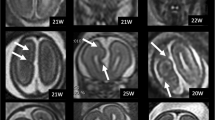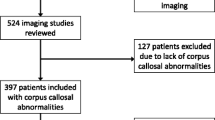Abstract
Agenesis of the corpus callosum is currently diagnosed prenatally with ultrasound and MRI. While the diagnostic aspects of callosal defects are widely addressed, anatomo-histological data from fetal autopsies are sparse. Callosal defects were present in 50 fetal autopsies. Four distinct groups of complete, partial, hypoplastic, and mixed defects were determined by the gross and histologic details of the corpus callosum. These details helped to rule out other midline defects such as holoprosencephaly. Additional autopsy findings enabled specific diagnoses and suggested etiopathogeneses. Hypoplastic and mixed defects were associated with more abnormalities of the cerebral hemispheres and internal organs. The four groups did not differ according to gender, external dysmorphism, or cerebellar and brainstem anomalies. Defects were classified as syndromic (68 %), encephaloclastic (8 %), undetermined (14 %), or isolated (10 %) based on the autopsy findings. Isolated agenesis of the corpus callosum was diagnosed in only 10 % of the cases in this series, compared to higher numbers diagnosed by prenatal ultrasonography and MRI. Therefore, the autopsy, through its detailed, careful evaluation of external, as well as gross and histological internal features, can elucidate the etiopathogenesis of agenesis of the corpus callosum and suggest specific diagnoses which cannot be ascertained by prenatal imaging.







Similar content being viewed by others
References
Bosnjak VM, Daković I, Duranović V, Lujić L, Krakar G, Marn B (2011) Malformations of cortical development in children with congenital cytomegalovirus infection—a study of nine children with proven congenital cytomegalovirus infection. Coll Antropol 35(Suppl 1):229–34
Bove KE (1997) Practice guidelines for autopsy pathology: the perinatal and pediatric autopsy. Autopsy Committee of the College of American Pathologists. Arch Pathol Lab Med 121:368–76
Edwards TJ, Sherr EH, Barkovich AJ, Richards LJ (2014) Clinical, genetic and imaging findings identify new causes for corpus callosum development syndromes. Brain 137:1579–613
Glass HC, Shaw GN, Sherr EH (2008) Agenesis of the corpus callosum in California, 1983–2003: a population based study. Am J Med Genet A 146A:2495–2500
Goodyear PW, Bannister CM, Russell S, Rimmer S (2011) Outcome in prenatally diagnosed fetal agenesis of the corpus callosum. Fetal Diagn Ther 16:139–145
Hetts SW, Sherr EH, Chao S, Gobuty S, Barkovich AJ (2006) Anomalies of the corpus callosum: an mr analysis of the phenotypic spectrum of associated malformations. Am J Roentgenol 187:1343–1348
Macpherson TA, Valdes Dapena M (1998) The perinatal autopsy. In: Wigglesworth JS, Singer D (eds) Perinatal pathology. WB Saunders, Philadelphia, pp 93–122
Paul LK, Brown WS, Adolphs R, Tyszka JM, Richards LJ, Mukherjee P, Sherr EH (2007) Agenesis of the corpus callosum: genetic, developmental and functional aspects of connectivity. Nat Rev Neurosci 8(4):287–99
Pisani F, Bianchi ME, Piantelli G, Gramellini D, Bevilacqua G (2006) Prenatal diagnosis of agenesis of corpus callosum: what is the neurodevelopmental outcome? Pediatr Int 48(3):298–304
Prasad AN, Bunzeluk K, Prasad C, Chodirker BN, Magnus KG, Greenberg CR (2007) Agenesis of the corpus callosum and cerebral anomalies in inborn errors of metabolism. Congenit Anom (Kyoto) 47(4):125–35
Santo S, D’Antonio F, Homfray T, Rich P, Pilu G, Bhide A, Thilaganathan B, Papageorghiou AT (2012) Counseling in fetal medicine: agenesis of the corpus callosum. Ultrasound Obstet Gynecol 40:513–21
Sotiriadis A, Makrydimas G (2012) Neurodevelopment after prenatal diagnosis of isolated agenesis of the corpus callosum: an integrative review. Am J Obstet Gynecol 206:337.e1–5 27. doi:10.1016/j.ajog.2011.12.024
Tang PH, Bartha AI, Norton ME, Barkovitch AJ, Scherr EH, Glenn OA (2009) Agenesis of corpus callosum: an MRI analysis of associated abnormalities in the fetus. Am J Neurol Radiol 30:257–263
Acknowledgments
The authors wish to thank the lab technicians at the Department of Pathology at Meir Medical Center, especially Ms. Masha Munster for their dedicated skillful work and kind collaboration over many years.
Author information
Authors and Affiliations
Corresponding author
Ethics declarations
Conflict of interest
All authors declare that they have no conflict of interest.
Rights and permissions
About this article
Cite this article
Kidron, D., Shapira, D., Ben Sira, L. et al. Agenesis of the corpus callosum. An autopsy study in fetuses. Virchows Arch 468, 219–230 (2016). https://doi.org/10.1007/s00428-015-1872-y
Received:
Revised:
Accepted:
Published:
Issue Date:
DOI: https://doi.org/10.1007/s00428-015-1872-y




